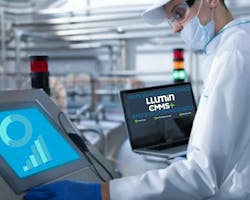By Miller Milling
It’s been a roller coaster ride these past few years for the food & beverage industry – supply bottlenecks, worker shortages, not to mention the numerous inefficiencies that continue to exist in managing work orders, maintaining equipment and dealing with managing silos of automation throughout manufacturing plants.
What if a lot of these pain points could be alleviated for your company? At Miller Milling, we managed just that with the installation of a single, centralized computerized maintenance management system (CMMS). It’s a journey many food processors have undertaken and others are still considering. Based on our experience, you should take the plunge if you haven’t already.
Smarter manufacturing connects, automates, tracks and analyzes plant operations, eliminating silos of automation that prevent a more integrated approach. The food industry is still undergoing a digital transformation starting with plant floor operations. We wanted to share one flour manufacturer’s digital transformative experience and how it helped manage supply roadblocks and eliminate disconnects between our systems.
Maintenance of equipment that involves processing food or producing beverages must be completed on time, resources need to be used efficiently and assets need to remain in good working condition to really run effectively.
Miller Milling, one of the top four milling operations in the U.S., produces flour for consumers as well as for foodservice customers with flour for pastries, bread, pizza doughs, pasta and tortillas. For Miller Milling, optimal equipment performance and efficient work order management continue to be cornerstones of successful maintenance operations.
Legacy systems
Before deploying a single, centralized CMMS platform, Miller Milling used two different systems: one for purchasing and one for work orders. Unfortunately, both systems lacked real time automation, an ability to scale and the interoperability needed to easily integrate with other systems. They were just inadequate for our company’s needs.
Prior to our upgrade, work orders were mostly paper-based, meaning they were issued on paper and distributed to maintenance personnel, who would complete the task. This, however, quite often resulted in errors, caused difficulties tracking task completion and its duration, imposed limitations in distributing necessary safety and maintenance information and even lost information. For instance, work orders would go missing and details on what was accomplished at the time the work completed would go unrecorded.
“The program was very outdated. We were never sure which tools or parts we had in our inventory,” explains Alisha Ruiz, who is in charge of HR, invoicing and CMMS+ at Miller Milling’s plant in Fresno, Calif. “We stopped using the work orders system because it wasn't staying up to date with our huge parts inventory. We wound up either making costly purchases that weren’t necessary or discovering too late that we didn’t have a part we needed.
“It’s a big deal when we have a machine go down, and we would have to stop production while we wait for a part that should have been in our inventory already,” she continues.
The legacy purchasing system meant a lot of extensive paperwork. “We had to keep paper invoices for managers to physically approve and sign, which took a lot of time. Then we had to send the paper invoices to corporate via UPS for payment,” Ruiz describes.
Elevating maintenance operations
As Miller Milling moved from legacy systems to a CMMS from LLumin, information and data gathering was completely revamped and optimized, which ensured the right data would go to the right maintenance and operations personnel.
Processes around safety, maintenance planning, speed to completion and -- most importantly -- critical supplies tracking and vendor collaboration efforts were all streamlined, and they made the factories more efficient.
Today at Miller, all labor, skills and workforce management are optimized, right alongside the assurance that timely and accurate resources are delivered. Additionally, for all the plants, we learned the key elements involved in work order management:
- Documentation: Work orders provide a written record of maintenance activities, which is essential for compliance, audits, historical reference, knowledge sharing and, very importantly, costs.
- Prioritization: Work orders help prioritize maintenance tasks based on urgency, safety, and criticality, ensuring that the most important work is addressed first.
- Resource allocation: Work orders specify the required materials, equipment, and labor, enabling efficient resource allocation.
There are certain important steps to take to make the asset management process as effective as possible in guiding maintenance and facility management activities. For all our plants, Miller Milling realized that each step was critical to ensuring maintenance tasks were initiated, executed, documented and analyzed.
The process began with initiating work orders. These work orders originated from various sources, including employee maintenance requests or automated alerts from the condition monitoring-enabled CMMS platform. Whether it’s a request for routine maintenance or a response to an unexpected issue, the initiation stage is where it all starts.
Once a work order was initiated, the next step was planning and scheduling. This phase involved defining the scope of the maintenance task, estimating the time required for completion and assigning it to the appropriate team member. The next phase was execution, where the maintenance tasks are performed. Our skilled technicians and maintenance personnel put the plan into action, carrying out repairs, inspections or other required activities.
Once the maintenance task is completed, they document the results. This involves recording observations during the task, documenting the parts and materials used and tracking the expended labor hours. Documentation also is crucial for future maintenance planning.
The maintenance teams then focused on review and analysis after closing the work order. Reviewing past work helped maintenance teams refine their processes and improved performance.
Key results
Now all the plants utilize a cloud-based, mobile-ready CMMS platform for their advanced work order management activities. It has transformed many of the plants’ maintenance operations by prioritizing work orders, such as putting the focus on plant safety, asset criticality and/or regulatory requirements. This ensures that high-priority tasks are addressed first. Additionally, we are able to automate work order creation, assignment and tracking, in the process lowering administrative costs and improving response times.
Using mobile access, our maintenance teams receive and update work orders on the go, which improves communication and response times to urgent tasks. “If someone notices that a machine isn’t working properly, they put a work order into our CMMS+, which outlines the problem and auto routes to appropriate teams,” says Ruiz. “The enhanced workflow is saving people time, and the Miller Milling workforce is happier than ever—an unexpected and welcomed result.”
Miller Milling is able to gain valuable insights through data analytics, which helps our maintenance managers make informed decisions rather than doing so by instinct. Our equipment maintenance teams that prefer to use mobile devices can now access and update work orders in real-time. It has really enhanced communication and efficiency.
Through scheduled maintenance, the teams are able to prioritize work orders based on factors like safety, asset criticality and regulatory requirements. This ensures that high-priority tasks are addressed first. They are able to implement preventive maintenance schedules easily, reducing unplanned downtime and extending asset life.
“As the CMMS+ specialist, I can identify replacement needs well before a machine fails, just by looking at the equipment’s maintenance history,” says Ruiz.
Finally, improvements in inventory control mean that we can manage parts and materials efficiently, ensuring that the right items are available when needed. And since team members can log in and approve payments from any location, they no longer worry about limited bandwidth resulting in past-due bills, which could hinder production.
With over 2,000 unique parts in Miller Milling’s inventory, accurate inventory tracking is imperative. Now, not only can the Fresno plant’s team see its inventory, but they can also see the inventory at every other Miller Milling facility. If the Fresno mill, for example, needs a part and the Oakland mill has multiples of that part, Oakland can send a part to Fresno, saving the company money and preventing it from accumulating an overabundance of any individual part.
Key performance indicators (KPIs) help us to measure the efficiency and effectiveness of the work order management process. It permits us to identify areas for improvement based on data analysis. Another KPI for Miller Milling is around how our CMMS+ shortens repair and maintenance times by simplifying the work order process from start to completion.
Part of our digital transformation
An important reason driving the digital transformation for food & beverage manufacturers is the need to lower operating costs and increase efficiency. By maximizing asset usage, avoiding unscheduled downtime and reducing the need for emergency maintenance, automation can assist food processors in lowering their operational expenses. Companies can increase productivity, cut down on lead times, and offer better customer service by increasing efficiency.
Today, CMMS platforms have become an intricate part of an organization’s digital transformation, offering flexibility, scalability and affordability in the fact that they can be deployed as a cloud-based solution, easily shared among teams within a plant or multiple plants. For Miller Milling, the CMMS improved production, work performance, team collaboration and overall morale.



